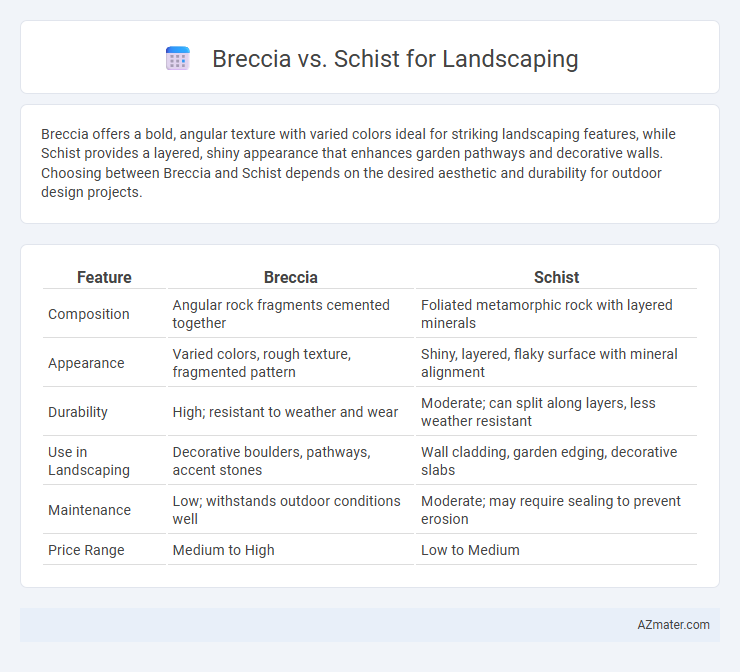Breccia offers a bold, angular texture with varied colors ideal for striking landscaping features, while Schist provides a layered, shiny appearance that enhances garden pathways and decorative walls. Choosing between Breccia and Schist depends on the desired aesthetic and durability for outdoor design projects.
Table of Comparison
| Feature | Breccia | Schist |
|---|---|---|
| Composition | Angular rock fragments cemented together | Foliated metamorphic rock with layered minerals |
| Appearance | Varied colors, rough texture, fragmented pattern | Shiny, layered, flaky surface with mineral alignment |
| Durability | High; resistant to weather and wear | Moderate; can split along layers, less weather resistant |
| Use in Landscaping | Decorative boulders, pathways, accent stones | Wall cladding, garden edging, decorative slabs |
| Maintenance | Low; withstands outdoor conditions well | Moderate; may require sealing to prevent erosion |
| Price Range | Medium to High | Low to Medium |
Introduction to Breccia and Schist in Landscaping
Breccia and schist are popular natural stones used in landscaping for their unique textures and visual appeal. Breccia features angular fragments cemented together, offering a rugged and dynamic look ideal for patios, pathways, and decorative walls. Schist displays a foliated, layered structure with a shiny, crystalline surface that provides an elegant and sophisticated appearance suitable for garden accents and retaining walls.
Geological Formation of Breccia and Schist
Breccia is a sedimentary or volcanic rock formed from angular fragments of minerals or rocks cemented together by a fine-grained matrix, typically resulting from tectonic processes or volcanic eruptions. Schist is a metamorphic rock characterized by its foliated texture and formed under high temperature and pressure conditions that realign platy minerals like mica into distinctive layers. Both Breccia and Schist offer unique aesthetic and structural properties for landscaping, with Breccia showcasing rugged, angular fragments and Schist displaying shimmering, layered surfaces.
Visual Characteristics: Breccia vs Schist
Breccia features angular, fragmented rock pieces cemented together, creating a bold, multi-textured appearance with striking color contrasts ideal for dramatic landscaping accents. Schist exhibits a foliated, layered structure with shiny, flaky minerals like mica, producing a shimmering, elegant surface that complements natural garden settings. The visual impact of Breccia lies in its chaotic, rugged look, while Schist offers a more uniform, refined aesthetic for outdoor design.
Durability and Longevity Comparison
Breccia's angular fragments cemented together create a highly durable, weather-resistant surface ideal for landscaping applications exposed to heavy foot traffic. Schist, characterized by its foliated texture and mineral alignment, offers good durability but is more prone to splitting and weathering over time compared to Breccia. For long-lasting outdoor installations, Breccia generally provides superior structural integrity and resistance to erosion, making it a preferred choice for durable landscaping features.
Texture and Workability Differences
Breccia features a coarse, angular texture with sharp fragments cemented together, providing a striking, rugged appearance ideal for bold landscaping accents. Schist displays a foliated, layered texture with a slippery or flaky surface, offering a smoother, more elegant aesthetic suitable for pathways and decorative rock walls. Workability differs as breccia's hardness and angularity require specialized cutting tools, while schist's foliated structure allows easier splitting and shaping for intricate design elements.
Color Variations and Aesthetic Appeal
Breccia offers a striking visual impact with its angular fragments and varied color palette, ranging from deep reds and browns to lighter tans and grays, making it ideal for bold, textured landscaping designs. Schist presents a more uniform and layered appearance, often exhibiting earthy tones like greens, grays, and silvers with a natural shimmer that enhances garden aesthetics through subtle elegance. Both stones contribute distinct visual qualities, with Breccia excelling in dramatic contrast and Schist providing sophisticated sheen and consistency in outdoor spaces.
Environmental Impact and Sustainability
Breccia and schist each present different environmental impacts and sustainability factors for landscaping; breccia, composed of angular rock fragments cemented together, often requires less intensive quarrying processes, reducing habitat disruption and energy consumption. Schist, known for its foliated texture and mineral layers, may involve more extraction and processing energy, but its durability and weather resistance contribute to long-term sustainability with minimal maintenance. Selecting breccia or schist based on local availability and recycling potential enhances eco-friendly landscaping choices by minimizing transportation emissions and resource depletion.
Cost Factors: Breccia vs Schist
Breccia typically costs more than schist due to its unique angular fragment composition and limited quarry availability, which increases extraction and processing expenses. Schist, known for its foliated texture and widespread deposits, tends to be more affordable and easier to source, leading to lower overall landscaping costs. Installation expenses also vary, with breccia's hardness requiring specialized tools, whereas schist's foliated layers allow for simpler cutting and shaping, influencing project budgets.
Best Landscaping Applications for Each Stone
Breccia's striking angular fragments and vibrant color variations make it ideal for decorative garden pathways, feature walls, and accent pieces that require bold visual interest. Schist's foliated texture and natural sheen offer durability and elegance, perfect for retaining walls, stepping stones, and rustic outdoor seating areas where both aesthetics and functionality are key. Each stone enhances landscaping through unique structural properties: Breccia excels in artistic statement installations, while Schist provides a sturdy, textured surface suitable for versatile outdoor use.
Choosing the Right Stone for Your Landscape Design
Breccia offers a striking, angular pattern with mixed colors perfect for bold, modern landscaping, while schist provides a layered, foliated texture ideal for rustic or naturalistic garden designs. Consider Breccia for pathways and accent walls to create visual interest through its fragmented appearance, whereas schist is better suited for retaining walls and garden edging due to its durability and slip-resistant surface. Selecting the right stone depends on your landscape's aesthetic goals, climate exposure, and required maintenance level.

Infographic: Breccia vs Schist for Landscaping
 azmater.com
azmater.com